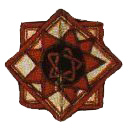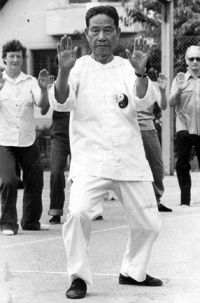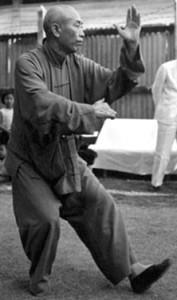
About
Taiji Quan practice by Wuyizidi
Human mind can concentrate on so many things at the same time ! But depending
on what level we are at, we pay attention to different things. It's like
a pyramid, each level is built upon everything below. Only after we have
practiced one thing long enough, to the point where we can now do it correctly,
automatically, every time, can we start working on the next thing.
Internal martial art skills work on different principles than external martial arts. They can seem counterintuitive. So in internal martial art training, we say "the analysis/understanding of skill goes from top to bottom, the actual practice of the skills goes from bottom to the top."
So let's start from the top, what should high level Taiji Quan skill look like? What type of ability are we trying to get? We can say all martial art is about delivering a physical force to the opponent's body, causing death or injury, and preventing the opponent from doing that to us. Martial art is the art of using force.
And what is our natural reaction when a large force comes toward our body? Fight or flight right. Here fight generally means using an equal or larger force to repel or defect the force so the force does not touch our body, and flight means moving the body away from that force. By Taiji Quan standards, both approach is too inefficient, if not ineffective (eg. someone already started doing a joint lock on you, he's using his whole body force against your wrist joint, here neither fight nor flight works).
So what do we do in Taiji Quan? One common analogy is the trap door. Your enemy confidently steps on something he thinks is solid, but when he puts his weight on it, the floor either breaks under him, or flips over, he loses his balance, and falls to his death. When he lands on the sharp sticks below, it's his own weight/momentum of the fall that kills him. This is called ???? "luring the enemy into emptiness".
So what type of skill makes "luring the enemy into emptiness" possible? It's called following. Following means you neither fight nor flight, like the trap door on the ground, you let your opponent touch you, and let your opponent's force move you, but you don't just let his force do what it wants. At first his force moves you, but then you move in a way that let your force move him.
Following requires sensitivity. As stated in Sun Zi, know your self and know your enemy. Knowing your enemy means knowing everything about his force: type, amount, timing, direction, duration, etc. There are different levels of sensitivity. At the highest level, you know what your opponent want to do, even before he started doing it.
And what makes sensitivity possible, one major thing is relaxation. Relaxation is not static, it doesn't mean you just go limp. Here's a great example, picture a bowl of water, with a ping pong ball floating on top of water. Your job is to push the ping pong ball all the way to the bottom of the bowl with one finger. Now, theoretically, it is plausible - if your push is so straight, that it goes through center of the ball exactly; and if there are any minute deviations, your finger must be sensitive enough to pick it up right away, and adjust accordingly. In practice, this is pretty much impossible. Any slight deviation from the center, and the ball with rotate to the side opposite of the one you had too much force on.
This is what ideal Taiji Quan skill should look like: here the amount or speed of the force applied is not an issue. All else being equal, as long as your sensitive is sharp enough, you can defeat whatever the enemy is trying to do. So the type of skill we are trying to acquire is of the light, agile, free, sensitive type.
How do we know our opponent? It starts with knowing ourself. Push hand training is about knowing your opponent, form training is about knowing ourself. Knowing ourself means by observing what we do under typical situations, know what we try to do naturally, and from that, we can begin to understand what anyone else might do.
Everyone is going to tell you "relax, sink qi down, have root", etc. But how do we do that? You can tell a person to relax his jaw muscle or unfurrow his brows, but the high level relaxing we are talking about, you can just tell someone/or yourself to do it, and you can do it right away. You need methods. This is where solo forms training comes in.
Now we know what we are trying to accomplish in forms training, we can talk about how to build the skill one level at a time, and what kind of things we need to address at each level:
1. The first step is to learn the movements of the form. If you have to think about "what comes after this" all the time, you really can't pay attention to anything else.
2. After you memorized the basic movements of the form, start to get familiar with the application ideas within each movement. The idea is not to practice those applications, but from knowing the applications, the position, angle, timing, and the general type of force you use in your movement will be correct. If you know it's a strike to the neck, you will not lower it to the chest. We are not doing sitting meditation, we are moving. Only correct movements can lead to correct feelings.
3. Basic Shen Fa (body mechanics): at part of achieving correct movement, we also pay attention to the basic requirements for the various parts of the body, the so called "Nine Basic Requirements" (suspend head, relax shoulder, sink elbow, ...).
4. Basic movement requirements for forms training:
- Centered and calm: your mind need to be clear and at peace first. If our mind is like a pond of clear water, then stray thoughts are like rocks that falls into it, stirring up dirt and sediments, making the water muddy. How can your body relax when the mind is not clear and calm?
- Neutral and upright: if a structure is leaning to one side, the top side will have to exert extra force to prevent the structure from falling right. If you do this you will not be able to relax. When you are perfectly upright and neutral, you have equal amount of open space in your spine in all directions, this allows you to move freely in all directions.
In Taiji Quan we talk about 3 leveling:
1) both eyes should be level to the ground,
2) both shoulders should be level to the ground, and
3) all sides of the hips should be level to the ground.
- calm/at ease: don't force things when doing the form. In terms of how low your postures is, how big your step is, how high you kick, if your conditioning is such that you cannot perform the standard, don't force yourself. Make it challenging, but don't try to do too much. If you try too much, you cannot relax right? Forcing leads to "bouncing": for example, lots of us have no problem kicking to the wrist level in normal or fast speed, but when doing it slow, the middle part is really hard to get through. It's a combination of strength and flexibility. So what do we naturally do, we speed up that part, bouncing in an uncontrolled manner to the end of the movement. That destroys the evenness quality we are after (discussed later). We want every stage of every movement be completely controlled.
- stretched out: be open/expansive. Let every joint in the body open and therefore relax. Again, we are talking about forcibly stretching out things, but naturally, gradually, slowly relax on its own. When you can open and relax all joints, you can achieve this spring-like quality in your body. In Chinese martial art we say "the body contains 5 bows". In the beginning, we want to make movements larger. When movements are big, it's easier to observe and understand what the correct feeling should be. If your range of movement is very small to start with, the movement will be over very quickly, you have less time to observe it.
- light: remember, neutralization skill is about lightness. When we do things lightly - using the absolute minimum amount of force to perform any movement, we can relax.
- agile: from lightness, we can get agility. Agile not only means quick, but changeable. Anytime the situation changes, we can respond appropriately, instantly.
- circular: in Taiji Quan everything is a circle, even ones that appears straight, like a straight push. Laozi said "big circle appears straight" (eg. earth is not flat). Remember, there the arm may be straight, but we are moving our whole body, not just the arm, overall it's a circular feeling.
- lively/free: related to agility. Think of the ping pong ball in water, it can move in all directions. This basically means we are not heavy, slow, plodding.
5. Basic methods for form practice:
- Slow: the faster we want to move, the more force we have to use right? And before we acquire the Taiji Quan skill, the more force we use, the less relaxed we are right? So we need to move slowly at first. Moving slow, using minimal force, that automatically help relax us.
- Smooth: the transition between movements must be smooth, to make it look like one big continuous movement, instead of two. This is why the original name for Taiji Quan is Chang Quan - Long Fist. This is why we use forms training in Taiji Quan: if we just do separate repetitions of single movements or short combination movements, it's hard to build the relaxing skill. So our movement should be like those of a chronometer: on inexpensive watches and clocks, the second hand jumps from one position to another. On high end watches, the second hand sweeps smoothly across the seconds without starts and stops. Starts and stops means accelerations and decelerations, with requires additional force, which makes relaxing hard.
- Even: this is about rhythm - the tempo of the movement remains the same from beginning to end. Our movement should be like a wind-up clock: from the moment it starts to the moment it rests, it moves at a constant speed. If the speed is not constant, again we will have a lot of accelerations and decelerations.
Doing the form this way: calm, balanced, light, agile, within challenging
but still comfortable range of motion, at constant speed, slow, all these
things will naturally cause the qi to sink down, which gives us root.
Only when we have root below, can our torso relax. If our bottom half
alone cannot make the whole body stable, the torso and head will try to
help out, at the very least, they will automatically be tense.
Relax, sink the qi down, etc, these are goals. When we practice, we just need to concentrate on the method for achieving those goals, with enough practice, the goal will take care of itself.
6. Know ourself:
In the end we want to borrow our opponent's force to beat him right? Before
we can do that, we should at least be able to borrow our own force. For
example, if we are starting from a twisted position, and we need to unwind
and extend one arm out in the same direction, we should minimize the amount
of force we use to extend that arm. We should be following/borrowing the
momentum of the torso unwinding to extend that arm. It should part of
one motion, not two. This is also part of using whole body force - when
every muscle of the body contribute to doing one big thing, then no one
part has to use all its force, again the result is relaxation.
7. Three levels of stance:
Low: mostly for conditioning
Medium: used most of the time, for skill practice
High: for fighting
8. Three types of forms practice:
According to tradition, forms should be practiced in sets of three. The
first set concentrate on whole body integration. The second set focus
on details, or application ideas. The third set focus on feeling.
9. Three external integration: the torso is one big piece, so when we say coordination, we talk mainly about the limbs, which can move fairly freely on their own. So the three external integrations are: movement of shoulder should be coordinated with hip, elbow with knee, and hand to foot. If the movements are not coordinated, then the force produced will be "incomplete".
10. Three internal integration: ok, I'm really not qualified to talk about what they should be. In any case this is already a huge list of things to work with...
Hope this helps...
Tai chi chuan is an internal Chinese martial art often practiced for health reasons and deadly if applied correctly and precisely.
In this group we try to share the secrets of tai chi especially in its movements in it being the ultimate martial arts nevertheless the misconception of this form of martial art is associated to the practice of tai chi for the sole reason for health purposes especially for the older generation, remains aplenty.
It is also typically practiced for a variety of other personal reasons: its hard and soft martial art technique, demonstration competitions, and longevity. Consequently, a multitude of training forms exist, both traditional and modern, which correspond to those aims. Some of tai chi chuan's training forms are well known to Westerners.
The core training involves two primary features: the first being the solo form??(ch'üan or quán, ?), a slow sequence of movements which emphasize a straight spine(though conforming to the classic of raise the back and sink the chest), abdominal breathing and a natural range of motion; the second being different styles of pushing hands (tui shou, ??) for training movement principles of the form in a more practical way.
Tai chi chuan is generally classified as a form of traditional Chinese martial arts of the Neijia (soft or internal) branch. It is considered a soft style martial art — an art applied with internal power — to distinguish its theory and application from that of the hard martial art styles.
The study of tai chi chuan primarily involves three aspects.
• Health: An unhealthy or otherwise uncomfortable
person may find it difficult to meditate to a state of calmness or to
use tai chi as a martial art. Tai chi's health training therefore concentrates
on relieving the physical effects of stress on the body and mind. For
those focused on tai chi's martial application, good physical fitness
is an important step towards effective self-defense.
• Meditation: The focus and calmness cultivated by the meditative
aspect of tai chi is seen as necessary in maintaining optimum health (in
the sense of relieving stress and maintaining homeostasis) and in application
of the form as a soft style martial art.
• Martial art: The ability to use tai chi as a form of self-defense
in combat is the test of a student's understanding of the art. Martially,
Tai chi chuan is the study of appropriate change in response to outside
forces; the study of yielding and "sticking" to an incoming
attack rather than attempting to meet it with opposing force. The use
of tai chi as a martial art is quite challenging and requires a great
deal of training.
|
|||
| En 1970 un ami me conseilla un livre tout nouveau « La
Vie dans la vie » ; il était écrit par Lizelle
Reymond orientaliste, philosophe, écrivain, qui fut mariée
à Jean Herbert fondateur de la collection Spiritualités
|
|||
|
|
| . |
Tung Ying Chieh (1898-1961)
was a well known master of the traditional Yang style of Tai
Chi Chuan. He was a top student of the famous 3rd generation
Yang Family Tai Chi Chuan master Yang Cheng Fu (1883–1936).
Tung Ying Chieh trained with Yang Cheng Fu for more than 17
years, and assisted with Yang with teaching when he went on
travels through China. |
2. The three main points: spirit,
intention, and posture (likeness of the movement’s names)
have to be there. If the posture is correct, then the spirit
and intention are there, and you will have good progression.
Also, you will feel differently every day. Learners should try
to feel the differences intentionally. Translated by Albert Tang, Little Mountain Tai Club Student, thanks to Guy Tomash, taichivancouver.com |

